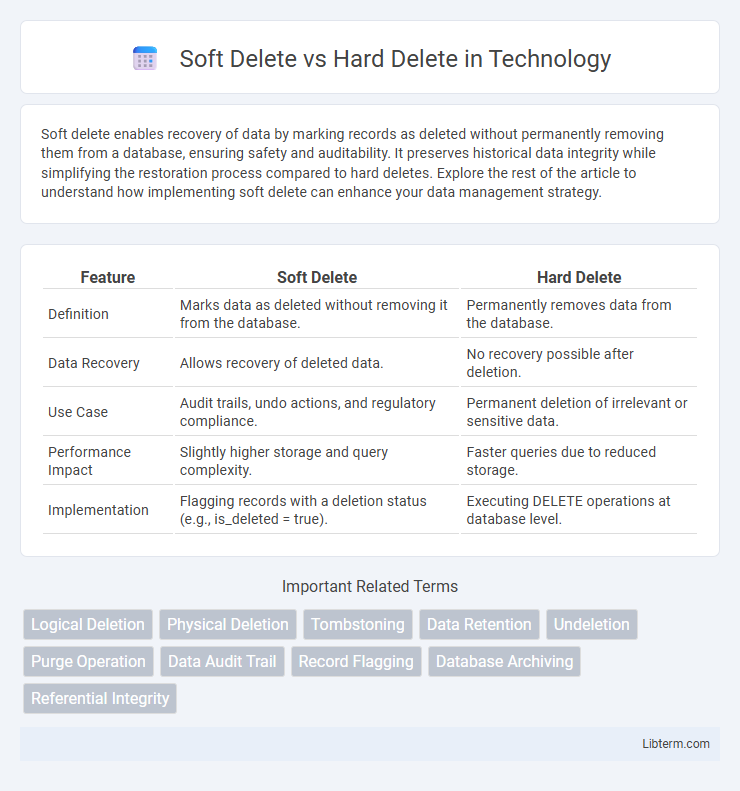Soft delete enables recovery of data by marking records as deleted without permanently removing them from a database, ensuring safety and auditability. It preserves historical data integrity while simplifying the restoration process compared to hard deletes. Explore the rest of the article to understand how implementing soft delete can enhance your data management strategy.
Table of Comparison
| Feature | Soft Delete | Hard Delete |
|---|---|---|
| Definition | Marks data as deleted without removing it from the database. | Permanently removes data from the database. |
| Data Recovery | Allows recovery of deleted data. | No recovery possible after deletion. |
| Use Case | Audit trails, undo actions, and regulatory compliance. | Permanent deletion of irrelevant or sensitive data. |
| Performance Impact | Slightly higher storage and query complexity. | Faster queries due to reduced storage. |
| Implementation | Flagging records with a deletion status (e.g., is_deleted = true). | Executing DELETE operations at database level. |
Understanding Soft Delete and Hard Delete
Soft delete involves marking data as inactive or deleted without removing it from the database, allowing recovery and audit trails. Hard delete permanently removes data, freeing storage but eliminating any possibility of retrieval. Choosing between soft delete and hard delete depends on data retention policies, compliance requirements, and system performance considerations.
Key Differences Between Soft Delete and Hard Delete
Soft delete marks data as inactive or deleted without removing it from the database, allowing recovery and maintaining data integrity, while hard delete permanently removes data, making it unrecoverable. Soft delete is ideal for audit trails and preventing accidental data loss, whereas hard delete improves storage efficiency and system performance by freeing up space. The key difference lies in data permanence: soft delete retains data invisibly, hard delete erases data completely.
Advantages of Implementing Soft Delete
Implementing soft delete preserves data by marking records as inactive instead of permanently removing them, enabling easy recovery and auditability. This approach enhances data integrity and compliance with regulations such as GDPR by retaining historical information. It reduces accidental data loss risks and supports version control within databases, improving overall system reliability.
Benefits of Using Hard Delete
Hard delete permanently removes data from a database, ensuring minimal storage usage and improved system performance by eliminating obsolete records entirely. This approach enhances data privacy and compliance by preventing recovery of sensitive information after deletion. It simplifies data management and backup processes since deleted records do not accumulate over time.
Use Cases for Soft Delete
Soft delete is ideal for use cases requiring data recovery, audit trails, or regulatory compliance, such as financial systems, healthcare records, and user account management. It enables easy restoration of accidentally deleted information without permanent data loss, supporting business continuity and forensic analysis. Systems that need to maintain historical data for reporting or legal purposes benefit significantly from implementing soft delete functionality.
Suitable Scenarios for Hard Delete
Hard delete is suitable for scenarios requiring permanent data removal to free storage space or comply with strict data retention policies, such as deleting obsolete user accounts or expired transaction records. It is ideal when data recovery is unnecessary, and irrevocable deletion enhances system performance and security by reducing database clutter. This method also suits environments with limited storage capacity where maintaining historical data is impractical.
Impact on Database Performance
Soft delete preserves data by marking records as deleted without physically removing them, which can increase query complexity and storage usage, potentially slowing database performance over time. Hard delete removes records permanently, freeing up storage and simplifying queries, thereby improving read and write speeds. However, frequent hard deletes may cause fragmentation, necessitating routine maintenance like indexing and vacuuming to maintain optimal performance.
Data Recovery and Restoration Considerations
Soft delete retains records by marking them as inactive or deleted, enabling efficient data recovery and restoration without requiring complex backup processes. Hard delete permanently removes data from the database, making recovery difficult or impossible unless prior backups exist, increasing risks associated with accidental deletions. Choosing between soft and hard delete impacts data integrity strategies, especially in systems requiring audit trails and quick restoration capabilities.
Security and Compliance Implications
Soft delete improves security and compliance by retaining data for recovery, audit trails, and regulatory requirements, reducing the risk of accidental or malicious data loss. Hard delete permanently removes data, which can enhance security by minimizing attack surfaces but may conflict with compliance mandates demanding data retention or traceability. Organizations must balance deletion methods to ensure data privacy, regulatory adherence, and risk management in their data lifecycle.
Best Practices for Choosing Between Soft Delete and Hard Delete
Best practices for choosing between soft delete and hard delete depend on data retention requirements, regulatory compliance, and system performance. Soft delete is ideal for maintaining data audit trails, enabling recovery, and supporting compliance with regulations like GDPR by marking records as inactive rather than removing them permanently. Hard delete suits scenarios where data privacy or storage limitations necessitate complete removal, ensuring sensitive or obsolete information is irretrievably deleted from the database.
Soft Delete Infographic

 libterm.com
libterm.com